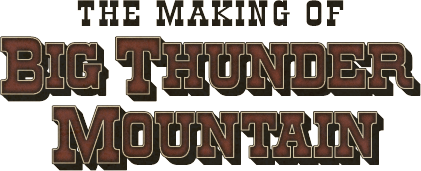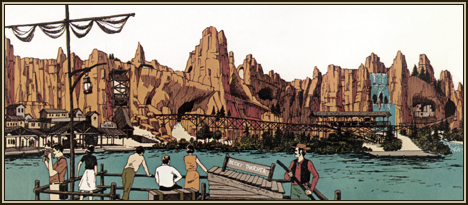
Nº 1 — Prairie Pirates
Pirates of the Caribbean, another timeless Disney classic, had been launched a few years earlier at Disneyland in California. By the time its sister park on the East coast was opening its gates in 1971, word of this one-of-a-kind ride had spread across the United States. Visitors were quick to voice their disappointment when they found the attraction missing from the new Magic Kingdom park.
Marc Davis, one of Pirates of the Caribbean’s principal creators, was already working on a similar ride for the Florida Resort… However, he picked a theme which would be more exotic to an East Coast audience: the Wild West. His Western River Expedition was going to be part of a huge attraction complex called “Thunder Mesa” which would have featured the scenic Pirates-like boat ride… and a small exciting runaway mine train.

Thunder Mesa concept art. © Disney.
The idea at the time was to build the mine train first and add the expansive Western River Expedition later on… The Imagineers hadn’t counted on the immense popularity of Pirates of the Caribbean, though. As visitors to the Florida resort were increasingly vocal about their disappointment in the ride’s absence, Walt Disney World management eventually gave in.
While former animator Davis had been busy working out show scenes for the character- and gag-driven Audio-Animatronics show, he let a young modelmaker called Tony Baxter take care of the mine train ride’s design.
This young Imagineer, who learned much of his craft from Marc Davis’ collaborator (and sometimes rival) Claude Coats, was originally only asked to give a shape to the mountainscapes surrounding the existing track design. However, he had his own ideas for a new type of energetic roller coaster ride that would tell a story through its mix of thrills with elaborate show scenes and set dressing.
He came up with a basic storyline that would start with an exhilarating ride through a bat-infested grotto and end with the climax provided by an earthquake in the depths of a gold mine. Another important part of Tony’s concept was to make it look as if the tracks were actually built around the existing landscape, rather than the other way around as was usually the case for this type of ride.
The management of Walt Disney World loved it — and proposed to build it as a stand-alone attraction, as Pirates of the Caribbean had eventually found its way to the East Coast in December 1973. After development continued for a while, however, the project was dethroned by another thrill ride set to open in the park, one that would reflect the United States’ fascination with space travel at the time: Space Mountain.
This attraction revolutionized roller coasters by introducing a computer-controlled “zone” system to safely allow several trains run on the same track: trains would always be separated by a set of safety brakes. Sensors would keep track of all the trains’ positions and brakes would only let a train pass if the preceding one had already moved on into the following “zone.”
Those advancements would later be successfully integrated into the Big Thunder ride control system, but for the moment, the success of Space Mountain’s “rocket ships” made the investment in an Old West mine train seem decidedly out of step to the resort’s management.
It seemed like the definite end to the “Thunder Mesa” project… But fortunately, a certain other park was looking for a new Frontierland experience.

| 
